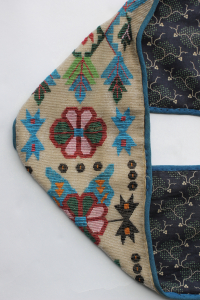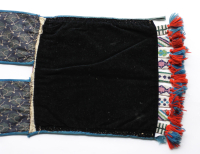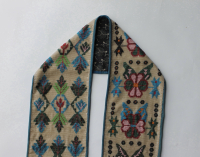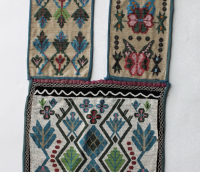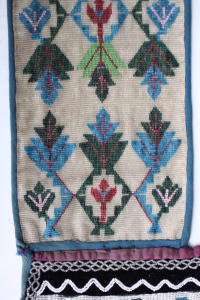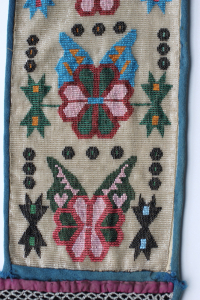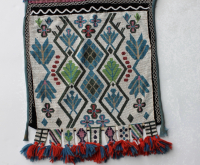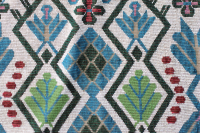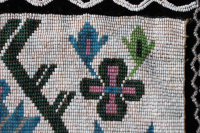Bandolier bag
Bandolier bag
Bandolier bag
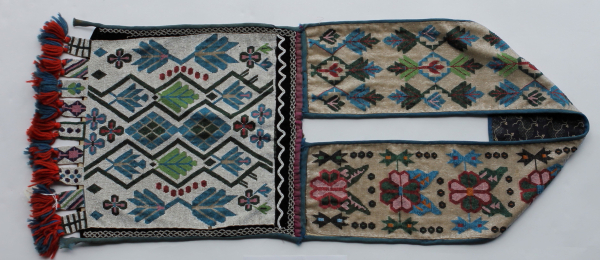
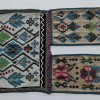

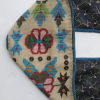
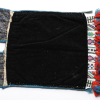

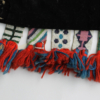

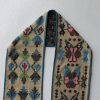
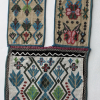
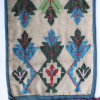
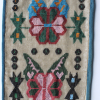
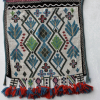
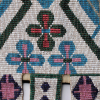
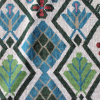

Bandolier with false pouch & two-piece strap, geometric & floral beadwork in overlaid spot stitch appliqué beading, tab with tassel
Condensed from catalogue description.
Read More About This Relative
Canvas, velvet, cotton muslin, seed beads, wool tape, silk, wool, thread.
Rectangular pouch with shoulder panel, Pouch sewn shut, Front pouch panel and shoulder have loom woven bead panels, Front panel sewn to canvas which has black velvet top, sides and backing, Wool tape border on all edges of shoulder panel and pouch sides, Wool tape ends form a fringe at each bottom corner, Nine loom woven beaded tabs along bottom edge, Wool tassel.
Front pouch panel and strap have loom woven panels of geometric and floral designs, overlaid spot-stitch applique, with multi-coloured opaque, semi-translucent, translucent, iridescent and red white core beads, Pouch panel has opaque white background, Strap panel has pearlized white background, Front of pouch panel sewn to canvas which has black velvet top, sides and backing, On velvet top and sides are translucent beaded zigzags, Additional curved line of opaque white beads along top, One piece loom woven panel for strap sewn to cotton muslin, with navy blue floral patterned cloth backing, Blue wool tape border on all edges of strap and pouch sides, Wool tape ends form a fringe at each bottom corner, Pouch top has a burgundy silk ribbon border, Nine loom woven beaded tabs along bottom edge, Tabs have multi-coloured geometric designs on white background, Each tab has two red and blue wool tassel, Sewn with black and white thread.
Bandolier bags most likely originated in the Upper Great Lakes region during the 1840s and 1850s. Fashioned exclusively from European materials and adorned with thousands of beads, bandolier bags were primarily for show, as a symbol of identity, wealth and status. Although initially functional, by the late 19th and early 20th centuries many of the bags had false pouches or none at all. Sometimes called "friendship bags", they were often created as gifts to strengthen relationships within communities or between nations. By the 1870s they had become an important element of formal dress worn mainly at ceremonies and celebrations by men, and occasionally by women. They wore them - singly or several at a time - crossed over the torso or draped around the neck. The wearing of more than one bag was generally the prerogative of a leader or a person of high honour." (McCord, 2013). Bandolier adopted by Ojibwa in 19th century after seeing bullet pouches used by British soldiers. Bullet pouches were plain and decorated with crest or coat of arms. When idea adopted by Ojibwa, they were greatly prized and highly decorated ceremonial accessories. They became so highly prized by Ojibwa and other tribes (especially Sioux), that one bandolier could be traded for one pony. They became a status symbol of highest ranking Midewiwin priests.
From catalogue records
Provenance
Hudson's Bay Company Winnipeg Fur Trade Department collected materials in preparation for 250th anniversary celebrations of the HBC in 1920. Many of these items were used in the Processions and Pow Wow at Lower Fort Garry in May, 1920. [From catalogue records]. Acquired for the HBC Museum Collection in April 1922. One of 25,000 of artefacts from the original Hudson's Bay Company Museum Collection which was donated to the Manitoba Museum by the HBC in 1994.
Treaties: We Are All Treaty People , "Portraits of the North: Drawings by Gerald Kuehl"
From catalogue records
About This GRASAC Record
Manitoba Museum













Northeast Great Lakes Riverine
 Knowledge Sharing Platform
Knowledge Sharing Platform



